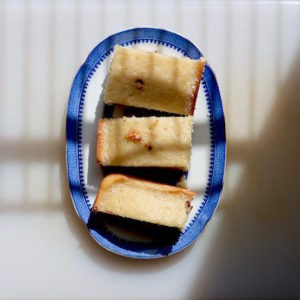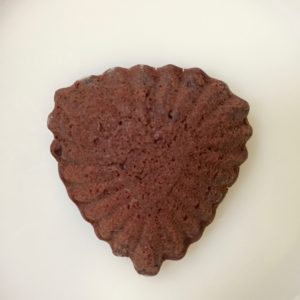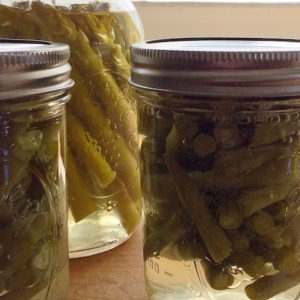The Wacky Cake: Not My Grandmother’s Bundt
Bill LeBlond, editorial director of Chronicle Books, once told a crowd at a cookbook proposal seminar that if he had to read one more book proposal from people who learned about cooking at their grandmothers’ knee, he would throw up.
Dianne Jacob, Will Write For Food
I spent a lot of time with my grandmother. None of it was in the kitchen. So I never learned to prepare her kreplach, gefilte fish, or poppy seed cookies. I simply took them for granted. Like weather.
The above implies I took my grandmother for granted as well. I did not. After my grandfather’s death, I began spending weekends at her apartment. I did this willingly, even after she started having small strokes. These episodes generally occurred after our nightly snack of coffee and Stella d’Oro cookies. In the morning, her mind clear, her speech articulate, she swore me to secrecy.
Finally the small strokes stopped being small. After her death, my family searched for her recipes. We found only scattered notes, the bits and pieces of recipes my grandmother could not recall: a few measurements, notes on a certain ingredient. Even these reminders were untitled.
Her signature cake was a chocolate bundt, dotted with semi-sweet chocolate morsels and topped with a lush glaze, likely confectioner’s sugar and more semi-sweet chocolate. She baked this cake on a near-weekly basis, handing it off to my family to take home.
My grandmother died in October 1982. The cake recipe died with her.
I am not a skilled enough baker to replicate that cake. Even if I could, I’m not sure I’d want to.
Nevertheless, the Wacky Cake, ridiculous name notwithstanding, tastes hauntingly similar. According to Anne Byrn, in her wonderful American Cake, the Wacky Cake was popular during the postwar years, when American housewives were eager consumers of quick dessert recipes.
The Wacky Cake calls for vegetable oil rather than butter or eggs. In additional to being frugal, this makes the cake parve, or neutral, an appealing choice for observant Jewish housewives like my grandmother. A parve dessert may be served after either meat or dairy meals without breaking the dietary laws of Kashrut. It is here, at the intersection of observant Judaism and history, that the Wacky Cake and my grandmother’s bundt cake cross culinary paths before parting ways.
—
To say the Wacky Cake is “easy” to prepare verges on the ridiculous. One needs neither kitchen skills nor machinery to bake it. The deft may mix the ingredients directly in the pan. The clumsy can use a bowl. Measure, mix, slide into oven.

The resulting cake tastes like far more effort was expended. The oil gives a moist, long-keeping crumb. Cocoa lends its inimitable flavor and texture (so use the good stuff). As befits an old-fashioned recipe, there is just enough sugar to offset the chocolate’s inherent bitterness: don’t expect sugar shock. In an era where the line between adult and childish tastes is increasingly blurred, the Wacky Cake reminds us that sweets are meant to be treats.

All the recipes I’ve seen for Wacky Cake include frostings: cream cheese, caramel, whipped cream. In memory of my grandmother’s lost recipe, I’ve added semi-sweet morsels to my Wacky Cake. A dusting of confectioner’s sugar atop is more than enough.

—
Jacob and LeBlond are right to warn prospective writers against nostalgia. This won’t stop legions of Jewish grandchildren, myself included, from missing their grandmothers’ cooking. Nor will it halt many of them from writing badly about it, and thinking that writing worthy of publication.

I never had the opportunity to cook at my grandmother’s knee. Therefore I will never have the opportunity to write badly about it, and mistake that writing for something finer.
As for Mr. LeBlond, let him eat Wacky Cake.

The Wacky Cake
Both Michelle Urvater, in Chocolate Cake: 150 Recipes From Simple To Sublime and Amanda Kludt, in the The Cherry Bombe Cookbook, (Claudia Wu and Kerry Diamond, Editors) offer this recipe, a simple and delicious classic. I’ve made only minor changes.
Serves 8 modest eaters or a few greedy people
Prep time: 10 minutes
Baking time: 35 minutes
1 1/2 cups all purpose flour
1 cup sugar
1 teaspoon kosher or fine sea salt
1 teaspoon baking soda
3 tablespoons unsweetened cocoa powder
1 teaspoon vanilla or almond extract
1 tablespoon distilled white vinegar
6 tablespoons vegetable oil
1 cup cold water
1 cup semi-sweet chocolate morsels (optional)
confectioner’s sugar, for the top (optional)
Butter and flour, for the pan
Instructions:
Preheat the oven to 350F
You will need a 9-inch glass pie pan to bake the Wacky Cake. Read the notes before baking.
Lightly grease and flour the pan.
Mix the ingredients in a large bowl. Pour them into the pie pan. Bake for 35 minutes, or until top of cakes is springy, the sides are pulling away from the pan, and a tester comes out clean. Take care to avoid piercing morsels when cake testing.
That’s it. Cool the cake on a rack. Dust with confectioner’s sugar, if desired.
Wrapped in plastic wrap or aluminum foil, the Wacky Cake will keep at room temperature up to four days. To freeze the cake, slice in wedges, remove from pan, and double wrap in plastic wrap.
Notes:
The original recipe does not call for greasing and flouring, but it aids in removal for freezing. I’ve also dusted with cocoa instead of flour.
I’ve baked the cake with vanilla and almond extracts. It’s delicious either way.
Wacky Cake recipes simply read “vegetable oil.” I’ve used canola and sunflower oil successfully.
Many recipes I consulted were very specific about using a glass pie plate. Older recipes call for an 8-inch glass pie plate, which can be hard to find. I use a 9-inch Pyrex pie plate, which is inexpensive and widely available.





